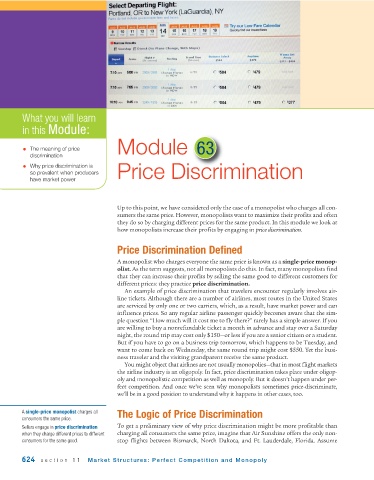Page 666 - Krugmans Economics for AP Text Book_Neat
P. 666
What you will learn
in this Module:
• The meaning of price Module 63
discrimination
• Why price discrimination is
so prevalent when producers Price Discrimination
have market power
Up to this point, we have considered only the case of a monopolist who charges all con-
sumers the same price. However, monopolists want to maximize their profits and often
they do so by charging different prices for the same product. In this module we look at
how monopolists increase their profits by engaging in price discrimination.
Price Discrimination Defined
A monopolist who charges everyone the same price is known as a single-price monop-
olist. As the term suggests, not all monopolists do this. In fact, many monopolists find
that they can increase their profits by selling the same good to different customers for
different prices: they practice price discrimination.
An example of price discrimination that travelers encounter regularly involves air-
line tickets. Although there are a number of airlines, most routes in the United States
are serviced by only one or two carriers, which, as a result, have market power and can
influence prices. So any regular airline passenger quickly becomes aware that the sim-
ple question “How much will it cost me to fly there?” rarely has a simple answer. If you
are willing to buy a nonrefundable ticket a month in advance and stay over a Saturday
night, the round trip may cost only $150—or less if you are a senior citizen or a student.
But if you have to go on a business trip tomorrow, which happens to be Tuesday, and
want to come back on Wednesday, the same round trip might cost $550. Yet the busi-
ness traveler and the visiting grandparent receive the same product.
You might object that airlines are not usually monopolies—that in most flight markets
the airline industry is an oligopoly. In fact, price discrimination takes place under oligop-
oly and monopolistic competition as well as monopoly. But it doesn’t happen under per-
fect competition. And once we’ve seen why monopolists sometimes price-discriminate,
we’ll be in a good position to understand why it happens in other cases, too.
A single-price monopolist charges all The Logic of Price Discrimination
consumers the same price.
Sellers engage in price discrimination To get a preliminary view of why price discrimination might be more profitable than
when they charge different prices to different charging all consumers the same price, imagine that Air Sunshine offers the only non-
consumers for the same good. stop flights between Bismarck, North Dakota, and Ft. Lauderdale, Florida. Assume
624 section 11 Market Structures: Perfect Competition and Monopoly

